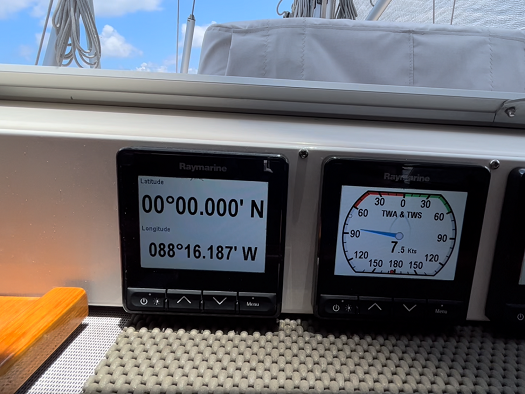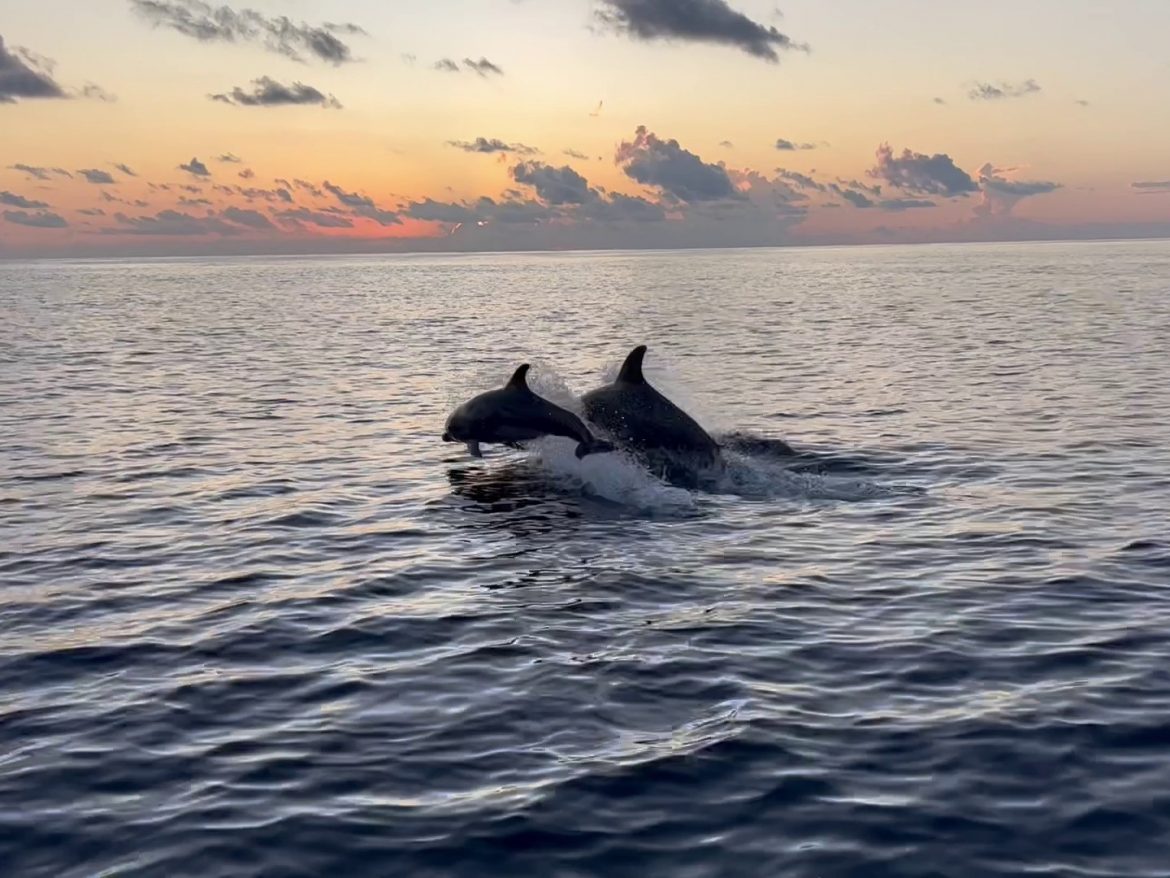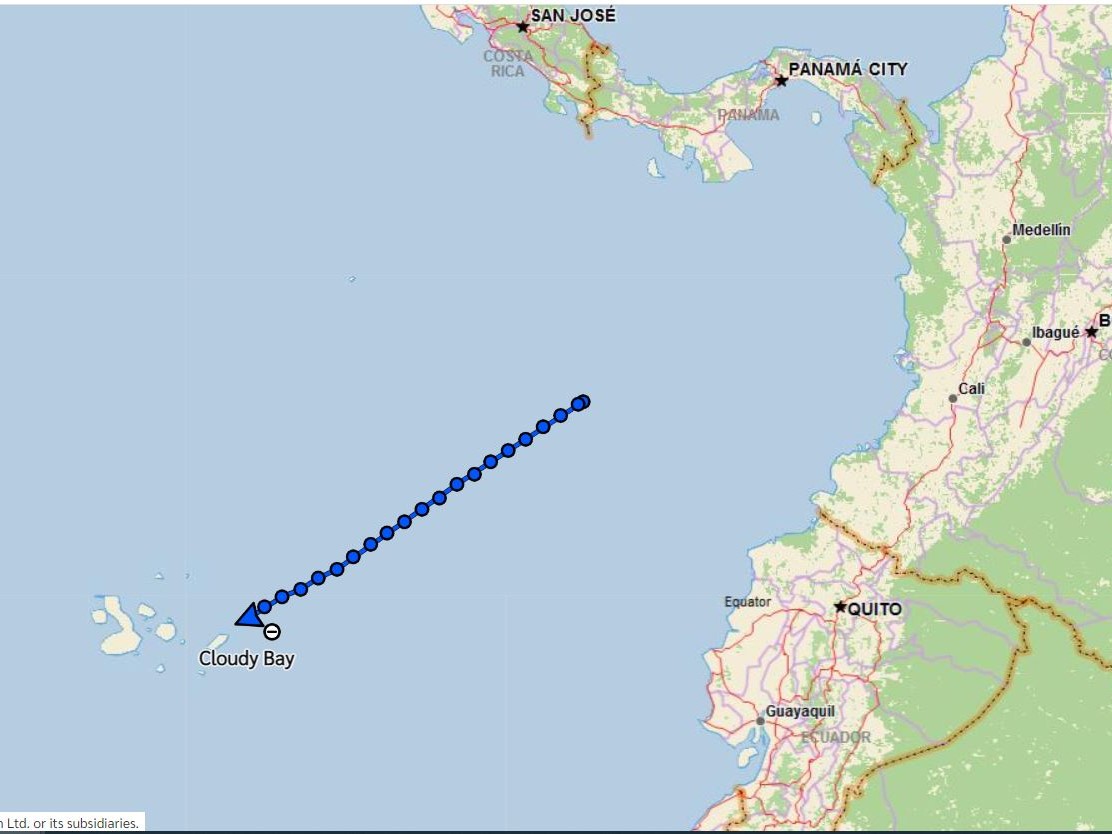Passage Panama to French Polynesia, days 4-6, 23-25 March: Windless days, tranquil ocean, dolphins, stary nights.
Last evening we ran out of wind by 9pm and were compelled to start the motor. It was a good run from Panama, having done 380nm in the first 2 days. But from now on the winds, if any, will be light. The next forecasted wind that we can actually sail in is close to Galapagos, 300 away. So, bar an hour or two where we tried to sail, we continued to motor for the next 60 hours.
As there were no significant time events, these 3 days all merge into one when it comes to this blog post.
Since meeting in Colombia, we are now loosely cruising with another boat, Graham and Julie on SV Salty Ginger. They had left Panama a day ahead of us, and we’ve been chatting daily about conditions we are each experiencing. When the wind died for them, they had gone in search of a forecasted wind about 100 miles south of us. They did find a light wind, just enough to sail, but the off-route diversion put them back a full day. On the other hand, while we have plodded-on motoring in the right direction, we have consumed 360litres of precious diesel and we are now compelled to stop in Galapagos for a fuel top-up before continuing onto French Polynesia, still 3,000 miles away.
Well, I guess we get to see Galapagos after all! However, it will just be a fuel stop, not an official entry to the islands. Yachts who want to officially cruise Galapagos pay almost $3000 in official and agency fees. And even then, their movements are restricted to just 2 harbours. They cannot cruise the islands without a park range on board, and that’s another $250 per day. While Ecuador is doing a good job preserving these islands, they are also using them as a cash-cow! One of the reasons we decided to remove Galapagos from our Pacific agenda. We’ll fly there another time and for a lot cheaper, thank you very much Mr. Ecuador!
Our 3 days of gentle motoring are in totally flat calm seas. Such a huge contrast to the Caribbean. In fact, it’s hard to believe we are in an ocean. Yes, ocean swell is present, but probably less than 1m and with such a long period (wavelength) you don’t even feel it.
The wind, if you can call it a wind, is totally fickle. 0-3kts patches in between patches of mirror-flat-calm. At one point we flew the drone to get a feel of Cloudy Bay gently motoring through the vastness of this calm ocean. It made us feel very small when we viewed the footage.
On day 4, we did have a surprise, and a bit of a fright. Out here away from any coastal shipping, we expect all marine vessels to have AIS (Automatic Identification System) such that we can see them (and they can see us) on our plotter from about 30 miles away – way before you can physically see the ship coming over the horizon. Because of this, during ocean passages we don’t have very good lookout discipline. So I was surprised one afternoon to see a small boat about 2 miles away with no AIS signature.
At first I thought it was a ship on the horizon. But binocular view revealed it to be a small open boat with apparently 2 people standing in it. Out here, 300 miles from land! Very odd. And then suddenly, and rather worrying, we saw it speeding towards us. Just the way you hear that pirates approach before they rape and pillage! But thankfully this boat was just a couple of Spanish speaking fishermen trying to tell us to go around their net, not through it. And our heart rates returned to normal. But still very odd they would be all the way out here, in an open boat, with one small outboard engine.
After that we paid more attention to our radar. And indeed, that same evening we passed a similar fishing boat.
During these tranquil days we started a ritual of having a drink (sangria) on the aft deck around sunset. The golden glow in the dusk sky, which also gave the sea a golden colour, was quite a spectacle. And the cherry on top was a new moon and a very bright Venus, which both dipped into the sea about 1 hour after sunset. Then the stars came out. So very bright, and blazing horizon to horizon. And when we were in the patches of mirror-like sea, the stars reflections in the water gave the feel that we were sailing in outer space with stars all around us, both up and down. Incredible. And I couldn’t resist saying to Oana: “now, you got to admit, you don’t get this view in everyday city life”.
And then there was the wildlife. The scene from the drone may have looked like a desert ocean, but it is far from it. We had two big shows put on by dolphins. First, a pod of quite small ones, doing their usual swimming on the bow. Then the next evening, at sunset, there was a large pod of very big dolphins that were super playful. Jumping fully out of the water and one even purposefully flipped his tail right next to us as we stood on Cloudy’s foredeck. It was like he actually wanted to splash us! Such incredible creatures. So beautiful, so powerful, yet also playful and intelligent. Seeing their synchronized swimming shows, performed just for us, you can’t help but be filled with joy. I’m convinced dolphins could be excellent therapy for depression!
And then each evening and all night we were joined by several large guls (or some kind of large seabird). They would eerily swoop back and forth across the bow, making gutural “clucking” noises at each other. At first, we thought they wanted to land on the boat to rest. But then we realized they were using the bow navigation lights to illuminate the water and pluck out tiny fish swimming close to the surface. With a flashlight on the water’s surface it becomes alive with lots of little golden eyes – each one a tiny fish. It’s no wonder the ancient mariners remarked on the abundance of life around these remote Galápagos Islands. It’s clearly true.
But sadly, none of it was volunteering to be on our dinner plate. We’ve had the fishing line out for days now, alternating between a lure for mahi-mahi and a lure for tuna. On day-6 we did finally hook something. The reel went off with its usual violent “bzzzzz” and as I started to reel-in we could see the fish fighting hard about 150m behind us. But then it managed to get off the hook. Bummer! Maybe I should get fishing lessons if I’m ever to catch the fresh tuna I’ve promised to Oana.
Also on this day-6, at 4am a consistent 5kt breeze finally came in on our port beam, as forecast. With the engine off and sails trimmed for light wind close-hauled we were soon ghosting along at 5-7knots in perfect silence. It felt wonderful to have the engine off, at long last. And we continued to sail right the way through day-6 and at midnight we were just 25nm east of Isla Cristóbal, the SE most island of the Galapagos archipelago.
As if sailing again wasn’t good enough, the big highlight of the day was crossing the equator into the southern hemisphere, a major milestone for us to herald. Oana already had some bubbly in the fridge, and we had put the latitude display up on the instruments for us to count down to zero degrees, zero minutes north before it flips to south and starts counting back up again. Oana got very excited when she saw 00.025’ and we rushed to get our cameras.
But rather than count down it was counting up! We’d missed it, we’d already cross without noticing 😮. So of course, we had to turn back and do it again just to see the 00 00 000 for our memories on the camera and ended up crossing the equator 3 times in just 15 minutes! Then there was a toast with bubbly and the expected photos. And although Neptune himself didn’t make an appearance (I forgot to dress up!) we made a toast to him in good faith.
The last thing to mention of significance is speed control. Out ETA to arrive at Wreck Bay, on the western end of Cristobal was the middle of the night. But we decided that if we were to see the island as we sailed along it, we’d better have some daylight. So having prayed for wind for the last 3 days, now that we finally have it we must keep our speed below 5kts for us to arrive at the island at dawn. It’s surprisingly difficult to make the boat sail slow when the wind is finally perfect to sail fast! So it felt like all we did all day was reef and unreef sails and adjust trimming to get our required 4.5kts. Maybe this could become an Olympic event in the sailing program: sailing at a fixed speed? It certainly requires skill!
Next blog will be Day 7, our visit to Isla Cristobal for refueling.





1 comment
I’m really enjoying your blogs Glen (although still missing your technical videos which were brilliant – but I can imagine how time-consuming must have been to make). Thanks for posting and wishing you happy sailing on CB.
Comments are closed.